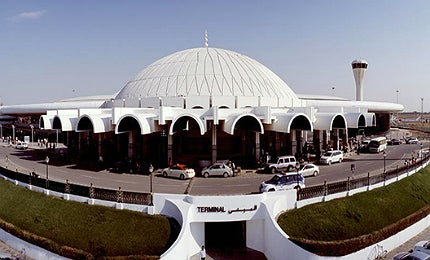
Sharjah International Airport (SIA, IATA: SHJ) is the main airport serving the city of Sharjah in the United Arab Emirates. It is located ten kilometres away from Sharjah City Centre and 15km away from Dubai. The airport was opened in 1977 and is owned by the Sharjah Airport Authority.
The airport currently serves as the main base for the low-cost carrier Air Arabia. It includes a 4,000m-long Category III runway (12/30) made of asphalt.
SIA is currently the second busiest freight handling airport in the Middle East, after Dubai International Airport. The airport has a passenger traffic handling capacity of more than eight million each year and a cargo handling capacity of 500,000t of cargo per year. As of October 2012, the airport handled five million passengers and 332,796t of freight.
The airport also integrates a free zone which became operational in 1995. The Sharjah Airport International Free (SAIF) Zone is now a major business hub for more than 5,500 companies.
Sharjah International Airport terminal
The airport includes one 105,300 square metre passenger terminal featuring 25 aircraft stands and eight departure gates. The terminal includes prayer areas, internet facilities, food courts, postal services, money exchanges, self-service check-in kiosks, a medical clinic, business centre and duty free shops.
Expansion of IATA: SHJ
A major redevelopment and expansion was carried out at the airport from 2005 to 2009 with an investment of Dh227m ($61.8m). The project was primarily driven by the increasing passenger traffic owing to the success of Air Arabia, which was launched in 2003.
The project included the construction of a new check-in area, departure and arrival lounges with three new air bridges, offices, expansion of the duty free area and food stalls, expansion of the arrivals area incorporating an in-bound baggage area, renovation of driveways and expansion of the parking lot.
The size of the check-in area was increased from 1,300 square metres to 4,000 square metres, the departures waiting area from 300 square metres to 1,300 square metres, the arrivals waiting area from 90 square metres to 500 square metres, the duty free area from 870 to 2,500 square metres, the food catering areas from 570 to 1,750 square metres and the seating area from 300 square metres to 1,100.
The holding lounges, which covered an area of 2,650 square metres, were renovated and expanded to 3,500 square metres. The project also increased the number of airline offices from 16 to 40 and the number of check-in counters was increased to 42. Ten additional warehouses were also constructed as part of the project.
The number of aircraft tarmacs at the airport was increased, from 44 to 65. Capacity of the airport’s parking facility was expanded to accommodate 800 vehicles from the former 550 vehicles.
In 2010, plans to construct a second runway at the airport were announced. The new 4,060m runway will be constructed parallel to the existing runway. The distance between the two runways will be 250m.
The new runway project is currently in the planning stage and the tentative year announced for completion is 2015. An investment of Dh500m ($136m) is expected to be made in the project, which will be funded by Sharjah Islamic Bank.
Cargo facilities at the Middle Eastern airport
The airport includes five cargo terminals spread across an area of 32,000 square metres. Terminal one is used for charter operations, terminal two is Lufthansa’s cargo hub, terminal three is for flight forwarders, terminal four is for customs and overflow imports and terminal five is for scheduled operations. The terminals feature separate cargo aircraft parking positions to handle nearly 16 types of aircraft.
Key players involved with UAE’s international airport
The redevelopment and expansion project was financed by Abu Dhabi Commercial Bank (ADCB). GHD acted as the designers and consultants for the project. Projac provided project management services. Evaluation of the passenger traffic in the airport was carried out by Halcrow using simulation modelling. The common use self-service (CUSS) kiosks used at the airport were supplied by SITA.
Related content
Dubai International Airport (DXB/OMDB), United Arab Emirates
Dubai International Airport has been the winner of Best Airport in Middle East Award for four consecutive years.
Al Maktoum International Airport, Dubai (DWC/OMDW), United Arab Emirates
Al Maktoum International Airport is located 40km from Dubai International Airport.
Abu Dhabi International Airport (AUH/OMAA), United Arab Emirates
Abu Dhabi International Airport, which is located in the emirate of Abu Dhabi, UAE, completed expansion projects in 2002.







